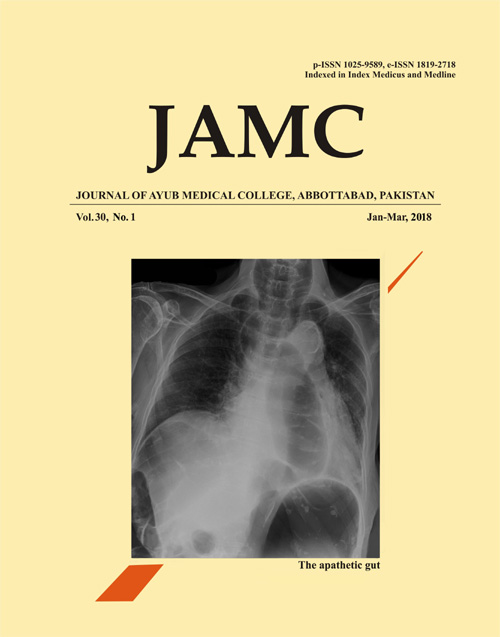FACTORS AFFECTING TREATMENT DURATION - A DILEMMA IN ORTHODONTICS
Abstract
Background: One of the first concerns of new orthodontic patients, apart from the outcome, is the duration of treatment. A better understanding of orthodontic treatment duration as well as factors affecting the treatment duration is useful for efficient patient counselling and improved clinical practice. Hence, the objectives of this study are to compare the treatment durations of subjects with Class I and Class II division 1 (II/1) malocclusions, and to identify the factors affecting the treatment duration of these malocclusions. Methods: This was a chart review conducted in the orthodontic department of the Aga Khan University Hospital, Karachi. The study sample comprised of 120 subjects and data were recorded from their treatment records. ANOVA and Bonferroni post-hoc were performed to determine the difference in treatment durations of Class I and Class II/1 malocclusions, whereas multiple linear regression was applied to identify the factors affecting the treatment duration. A level of significance (p‰¤0.05) was used for the statistical tests. Results: A statistically significant difference was found between the treatment durations of Class I and Class II/1 non-extraction (p=0.007), Class I non-extraction and Class II/1 extraction (p=0.001), and Class I and II/1 extraction (p=0.004) groups. The factors significantly increasing the treatment duration included missed appointments, breakages, and lower incisor proclination. Conclusion: Orthodontic treatment of Class II/1 malocclusion lasts longer than that of Class I malocclusion. Prolonged treatment time is associated with missed appointments, band/bracket debonds and increased lower incisor inclination. The variance in treatment time can be explained most significantly by number of missed appointments and breakages
Keywords: Class-I malocclusion; Class-II/1 malocclusion; treatment duration; missed appointments; breakages
References
Shia GJ. Treatment overruns. J Clin Orthod 1986;20(9):602-4.
Skidmore KJ, Brook KJ, Thomson WM, Harding WJ. Factors influencing treatment time in orthodontic patients. Am J Orthod Dentofacial Orthop 2006;129(2):230-8.
Beckwith FR, Ackerman RJ Jr, Cobb CM, Tira DE. An evaluation of factors affecting duration of orthodontic treatment. Am J Orthod Dentofacial Orthop 1999;115(4):439-47.
Popowich K, Flores-Mir C, Nebbe B, Heo G, Major PW. Comparison of Class I and Class II treatment duration among three different orthodontic practices. Semin Orthod 2006;12(1):52-9.
Popowich K, Nebbe B, Heo G, Glover KE, Major PW. Predictors for Class II treatment duration. Am J Orthod Dentofacial Orthop 2005;127(3):293-300.
Turbill EA, Richmond S, Wright JL. The time-factor in orthodontics: what influences the duration of treatments in National Health Service practices? Community Dent Oral Epidemiol 2001;29(1):62-72.
Fisher MA, Wenger RM, Hans MG. Pretreatment characteristics associated with orthodontic treatment duration. Am J Orthod Dentofacial Orthop 2010;137(2):178-86.
Bishara SE. Class II malocclusions: Diagnostic and clinical considerations with and without treatment. Semin Orthod. 2006;12(1):11-24.
Ijaz A. A cephalometric study to identify classification of malocclusion in patients attending orthodontic unit of the dental section at CH&ICH Lahore. J Pak Dent Assoc 2004;13:130-8.
Gul-e-Erum, Fida M. Pattern of malocclusion in orthodontic patients: A hospital based study. J Ayub Med Coll Abbottabad 2008;20(1):43-7.
Fink DF, Smith RJ. The duration of orthodontic treatment. Am J Orthod Dentofacial Orthop 1992;102(1):45-51.
O'Brien KD, Robbins R, Vig KWL, Vig PS, Shnorhokian H, Weyant R. The effectiveness of Class II Division 1 treatment. Am J Orthod Dentofacial Orthop 1995;107(3):329-34.
Vig PS, Weintraub JA, Brown C, Kowalski CJ. The duration of orthodontic treatment with and without extractions: A pilot study of five selected practices. Am J Orthod Dentofacial Orthop 1990;97(1):45-51.
Angle EH. Treatment of malocclusion of the teeth: Angle's system. 7th ed. Philadelphia: White Dental Manufacturing Company; 1907.
Siersbæk-Nielsen S, Solow B. Intra-and interexaminer variability in head posture recorded by dental auxiliaries. Am J Orthod 1982;82(1):50-7.
Vig KW, Weyant R, Vayda D, O'Brien K, Bennett E. Orthodontic process and outcome: efficacy studies-strategies for developing process and outcome measures: a new era in orthodontics. Clin Orthod Res 1998;1(2):147-55.
Alger DW. Appointment frequency versus treatment time. Am J Orthod Dentofacial Orthop 1988;94(5):436-9.
Shelton CE Jr, Cisneros GJ, Nelson SE, Watkins P. Decreased treatment time due to changes in technique and practice philosophy. Am J Orthod Dentofacial Orthop 1994;106(6):654-7.
Amditis C, Smith LF. The duration of fixed orthodontic treatment: a comparison of two groups of patients treated using Edgewise brackets with 0.018" and 0.022" slots. Aust Orthod J 2000;16(1):34-9.
Downloads
Published
How to Cite
Issue
Section
License
Journal of Ayub Medical College, Abbottabad is an OPEN ACCESS JOURNAL which means that all content is FREELY available without charge to all users whether registered with the journal or not. The work published by J Ayub Med Coll Abbottabad is licensed and distributed under the creative commons License CC BY ND Attribution-NoDerivs. Material printed in this journal is OPEN to access, and are FREE for use in academic and research work with proper citation. J Ayub Med Coll Abbottabad accepts only original material for publication with the understanding that except for abstracts, no part of the data has been published or will be submitted for publication elsewhere before appearing in J Ayub Med Coll Abbottabad. The Editorial Board of J Ayub Med Coll Abbottabad makes every effort to ensure the accuracy and authenticity of material printed in J Ayub Med Coll Abbottabad. However, conclusions and statements expressed are views of the authors and do not reflect the opinion/policy of J Ayub Med Coll Abbottabad or the Editorial Board.
USERS are allowed to read, download, copy, distribute, print, search, or link to the full texts of the articles, or use them for any other lawful purpose, without asking prior permission from the publisher or the author. This is in accordance with the BOAI definition of open access.
AUTHORS retain the rights of free downloading/unlimited e-print of full text and sharing/disseminating the article without any restriction, by any means including twitter, scholarly collaboration networks such as ResearchGate, Academia.eu, and social media sites such as Twitter, LinkedIn, Google Scholar and any other professional or academic networking site.










